Forest Biological Clocks: Ecosystems That Keep Time

TL;DR: Soft corals have weaponized their symbiotic algae to produce potent chemical defenses, creating compounds with revolutionary pharmaceutical potential while reshaping our understanding of marine ecosystems facing climate change.
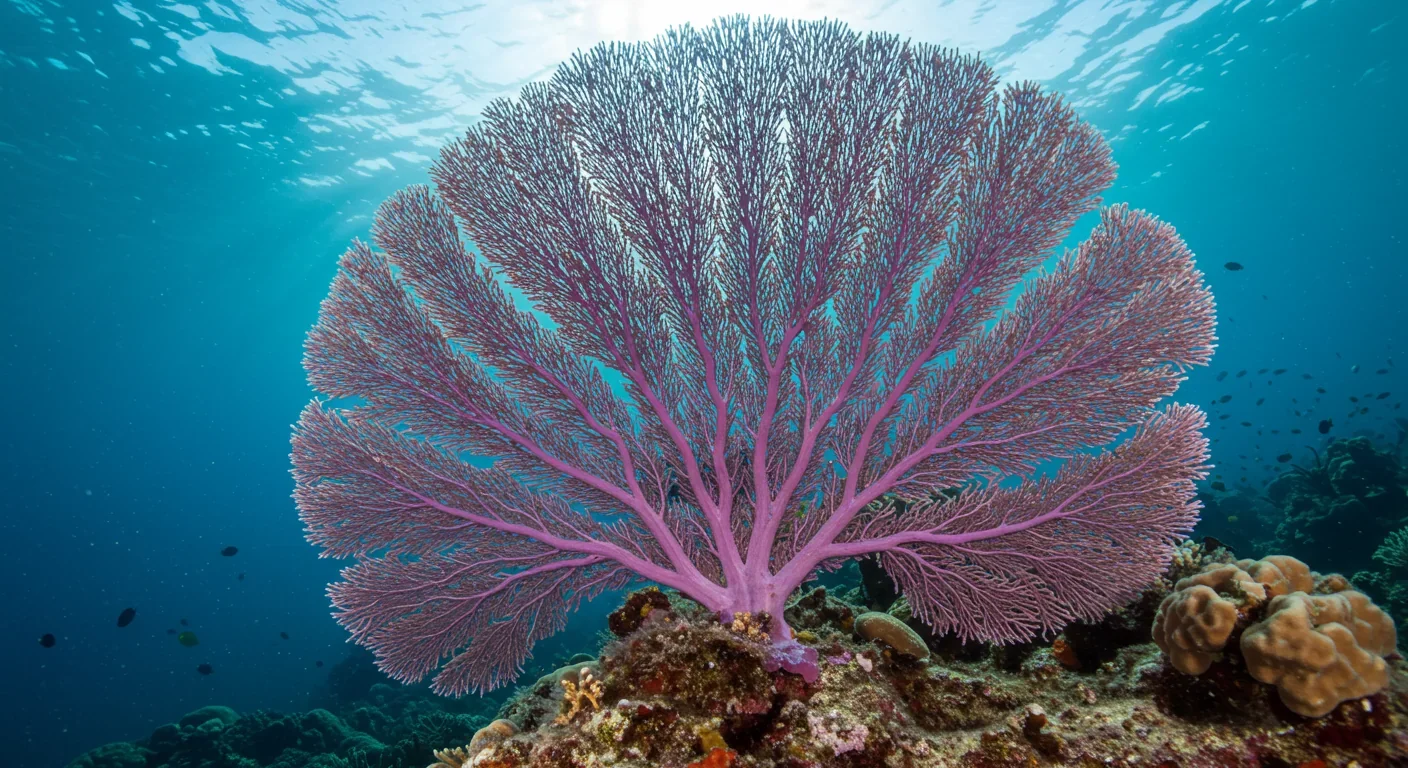
Within a decade, the pharmaceutical revolution you're hearing about won't come from rainforests or laboratory synthesis—it'll emerge from the chemical warfare laboratories of soft corals. These seemingly delicate marine organisms have spent millions of years perfecting biochemical strategies that could redefine how we treat inflammation, fight infections, and combat cancer. What makes this story remarkable isn't just the potent compounds they produce—it's how they've weaponized their own partners to make them.
Beneath the waves, octocorals (soft corals, sea fans, and sea whips) are waging sophisticated chemical warfare. Unlike their hard coral cousins that hide behind calcium carbonate fortresses, these flexible colonies have taken a radically different evolutionary path: they've turned their symbiotic dinoflagellates into chemical weapons factories. The implications reach far beyond marine biology, touching everything from antibiotic development to understanding how climate change will reshape ocean ecosystems.
For decades, marine biologists knew soft corals produced toxic compounds, but they assumed the coral tissues themselves were the source. Recent research has revealed something far more intriguing: octocorals actively manipulate the biochemistry of their symbiotic partners—microscopic algae called zooxanthellae—to manufacture defensive chemicals that would never exist in either organism alone.
Scientists studying Australian soft corals discovered that these animals produce cembranoid diterpenes, complex molecules that can either activate or suppress bacterial communication depending on their molecular structure. The kicker? The synthesis pathway requires metabolic contributions from both host and symbiont. The coral provides specific precursor molecules while directing its algal partners to transform them into potent toxins.
This isn't passive symbiosis—it's active biochemical manipulation. Octocorals essentially run chemical laboratories inside their tissues, with zooxanthellae serving as both energy providers and involuntary chemists.
This isn't passive symbiosis—it's active biochemical manipulation. Octocorals essentially run chemical laboratories inside their tissues, with zooxanthellae serving as both energy providers and involuntary chemists.
The story of coral chemical defense stretches back over 500 million years, but soft corals represent a relatively recent evolutionary innovation. When hard corals were investing metabolic resources into building calcium carbonate skeletons, octocorals took a different gamble. Around 250 million years ago, their ancestors began redirecting energy toward chemical defense systems.
This evolutionary split created two fundamentally different survival strategies. Hard corals became fortresses—rigid, defensive structures that could withstand physical assault but remained vulnerable to predators that could break through. Soft corals became flexible and adaptive, bending with currents while producing chemical deterrents that made them literally untouchable.
The parallel in human history is striking. Just as medieval Europe built stone castles while Asian civilizations developed gunpowder, corals split into builders and chemists. And like gunpowder, the coral chemical arsenal proved devastatingly effective. Studies examining 136 soft coral specimens found that species like Lemnalia and Sarcophyton produce compounds so toxic they can kill fish on contact.
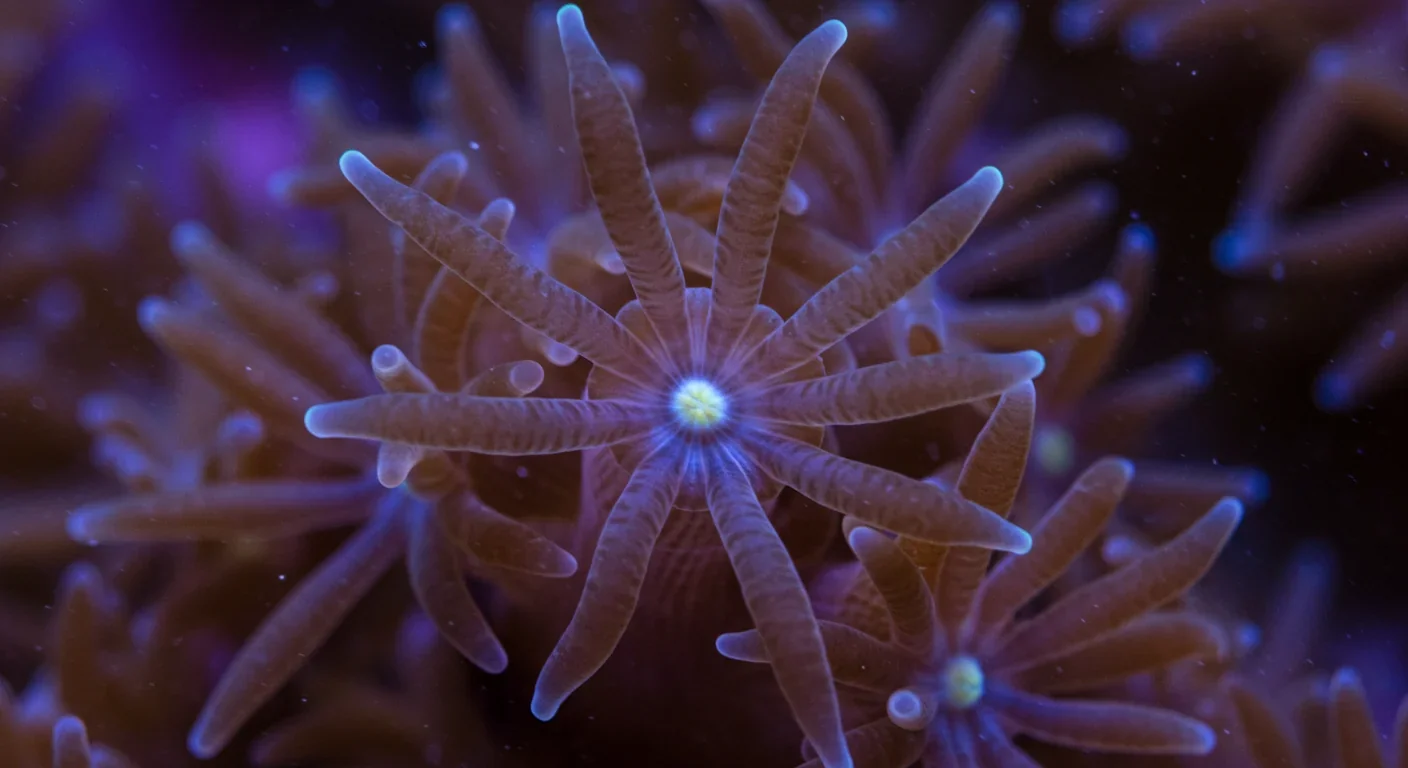
The chemistry underlying octocoral defense is breathtakingly complex. At the heart of the system lies the relationship between host and symbiont. Zooxanthellae provide up to 90% of their coral host's energy through photosynthesis during the day. But the partnership runs deeper than simple energy exchange.
Research on cnidarian-dinoflagellate symbiosis has revealed that octocorals and their algal partners engage in sophisticated biochemical cross-talk. The host coral produces certain lipid molecules with specific three-dimensional structures (R-enantiomers), while symbionts produce mirror-image versions (S-enantiomers). When corals enter symbiosis, these molecules begin moving between partners, with symbiont-derived compounds increasing in host tissues while host compounds appear in symbiont cells.
This molecular exchange isn't accidental—it's a regulated communication system. Octocorals use these lipid signals to direct symbiont metabolism toward producing defensive compounds. Think of it as chemical instructions: the coral tells its algae which molecules to make, how much to produce, and when to ramp up production.
"Cembranoid diterpenes with a furan ring or five-membered lactone induced quorum sensing, while compounds with larger lactone rings inhibited it."
— Frontiers in Marine Science study on Australian soft corals
The resulting chemical arsenal is diverse and deadly. Gorgonia ventalina, the common sea fan, produces secondary metabolites that incorporate into its tissues, making the entire organism unpalatable. The compound julieannfuran is so effective that predatory nudibranchs that do eat the coral don't digest the toxin—they sequester it in their own tissues for protection against their predators.
The mechanism octocorals use to control their symbionts represents a masterclass in cellular engineering. Recent studies have identified the key players in this biochemical manipulation.
First, octocorals regulate symbiont populations with precision. Research on thermal stress responses showed that corals don't just passively lose algae when stressed—they actively digest and expel damaged symbionts that aren't performing correctly. At normal temperatures (27°C), corals maintain steady symbiont populations. But when temperatures rise to 30°C, they selectively target and remove damaged cells while keeping healthy ones.
This quality control system ensures only functional "chemical factories" remain operational. It's analogous to a pharmaceutical company monitoring production lines and shutting down equipment that produces defective products.
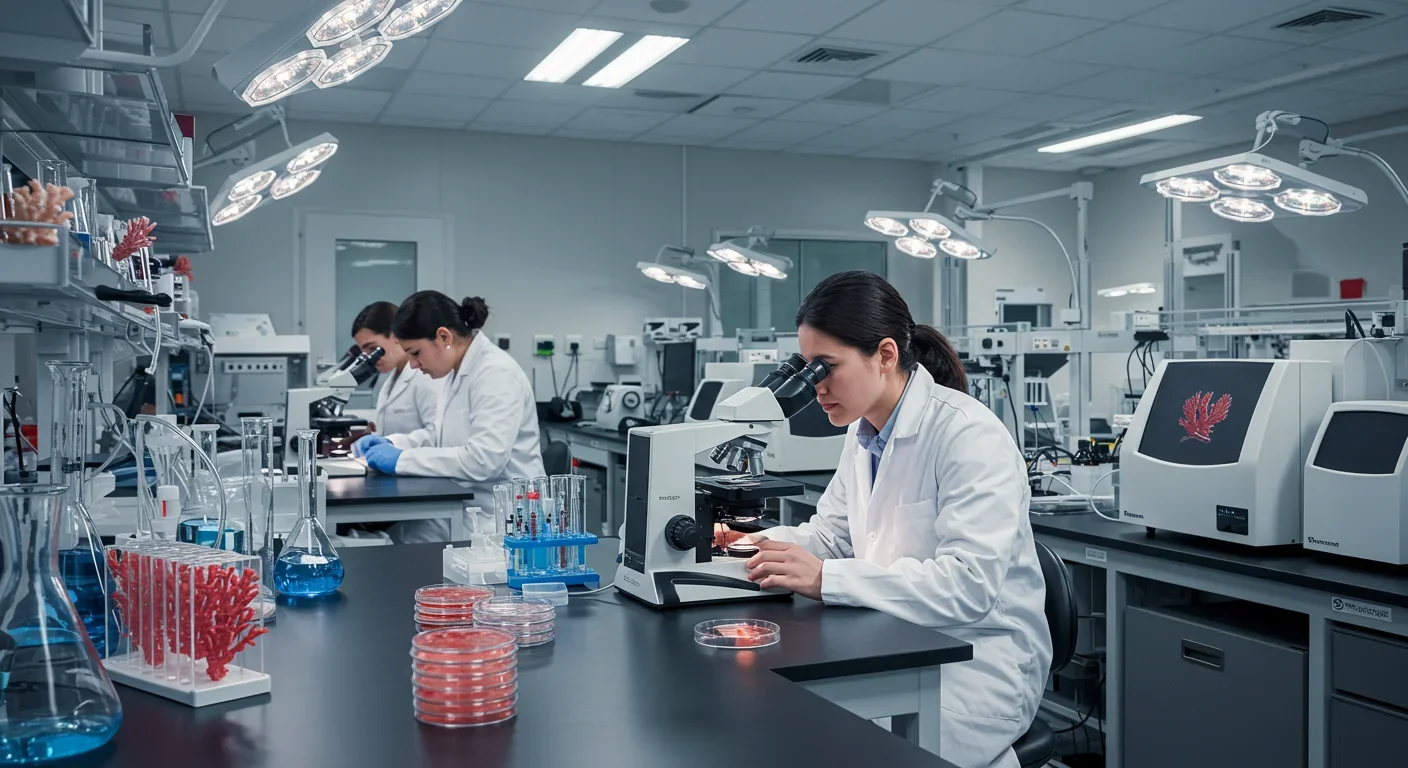
Second, octocorals modulate symbiont biochemistry through targeted signaling. The octadecanoid system acts as a chemical messaging network. When corals need specific defensive compounds, they send lipid signals to their symbionts, triggering the activation of particular biosynthetic pathways. The symbiont responds by upregulating enzymes like 13(S)-lipoxygenase, which catalyze the formation of defensive molecules.
Third, corals manipulate bacterial communities using symbiont-derived chemicals. Research on quorum sensing interference revealed that soft corals produce compounds that mimic bacterial communication molecules. Depending on molecular structure, these compounds either activate or suppress bacterial signaling. This allows octocorals to shape their microbial communities, promoting beneficial bacteria while suppressing pathogens.
The compound isolobophytolide, produced by Lobophytum compactum, increased bacterial diversity on coral surfaces by 200% when applied experimentally. The coral essentially cultivates a protective bacterial shield using chemical tools manufactured by its algal workforce.
The defensive chemicals octocorals produce have captured the attention of pharmaceutical researchers worldwide. These compounds evolved to solve problems remarkably similar to human medical challenges—fighting infection, reducing inflammation, and preventing unwanted biological attachments.
Pseudopterosins from Pseudopterogorgia elisabethae show powerful anti-inflammatory activity, more potent than many synthetic drugs. The compounds work by modulating immune signaling pathways, reducing inflammation without suppressing the entire immune system. Clinical trials are exploring applications for arthritis, inflammatory bowel disease, and wound healing.
Understanding how octocorals manipulate symbiont biochemistry could enable scientists to engineer algae or bacteria to produce valuable compounds on demand, eliminating the need to harvest wild corals.
The anti-fouling properties of octocoral chemicals offer solutions to a costly industrial problem. Marine organisms that attach to ship hulls cost the shipping industry billions annually in increased fuel consumption and maintenance. Current anti-fouling paints use toxic compounds that damage marine ecosystems. Soft coral chemicals prevent biological attachment through precise molecular mechanisms that don't harm non-target species.
Perhaps most promising, several octocoral compounds show anticancer activity. They work through novel mechanisms different from existing chemotherapy drugs, offering potential treatments for drug-resistant cancers. The chemical sarcophine, isolated from Sarcophyton glaucum, inhibits cholinesterase and shows activity against multiple cancer cell lines.
The pharmaceutical potential extends beyond individual compounds. Understanding how octocorals manipulate symbiont biochemistry could enable scientists to engineer algae or bacteria to produce valuable compounds on demand. Instead of harvesting wild corals, researchers could farm algae programmed with coral-derived genetic instructions to manufacture specific drugs.
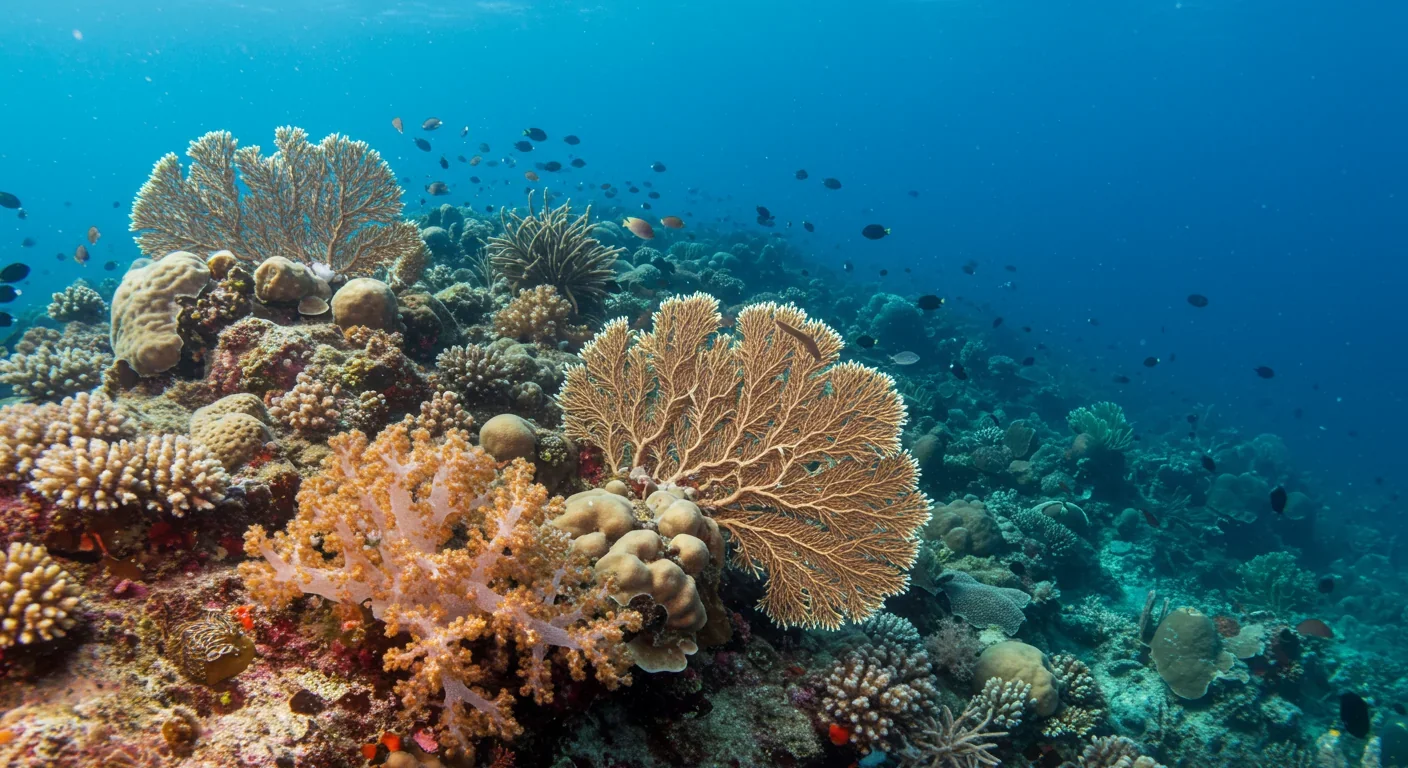
The story of octocoral chemical defense takes on urgency when viewed through the lens of climate change. As ocean temperatures rise and pH levels drop, the delicate biochemical partnership between corals and their symbionts faces unprecedented stress.
Research at Lord Howe Island, the world's southernmost coral reef, revealed that octocoral species respond differently to marine heatwaves. Cladiella sp. 1 bleached severely, losing symbionts and showing dramatically reduced photosynthetic efficiency. Bleached colonies had significantly lower symbiont densities and chlorophyll concentrations—exactly the resources needed for chemical defense synthesis.
Some colonies died outright, detaching from the reef during peak heat stress. But survivors showed remarkable resilience, recovering symbiont populations within seven months. This suggests octocorals possess adaptive mechanisms that could allow them to survive in a warming ocean—if temperature increases don't exceed their recovery capacity.
Other species showed surprising heat tolerance. Xenia cf. crassa actually increased symbiont and chlorophyll densities during the heatwave, while Cladiella sp. 2 remained stable. The variation in responses suggests some octocoral lineages may thrive as hard corals decline.
"Gorgonia ventalina has a high ecological resilience with populations maintaining their densities after two hurricanes in 2017."
— Dr. Peter J. Edmunds, research on Caribbean sea fan resilience
This has profound implications for reef ecology. In the Caribbean, surveys of Gorgonia ventalina populations showed high resilience after two Category 5 hurricanes in 2017. While hard corals were broken and killed, flexible sea fans bent with the storm surge and maintained population densities.
If octocorals prove more climate-resilient than hard corals, future reefs may be dominated by soft coral communities. These octocoral assemblages support different fish and invertebrate communities than hard coral reefs. The shift could reshape entire marine food webs, with cascading effects on fisheries and coastal economies.
Different regions show varying patterns of octocoral diversity. The West Philippine Sea harbors at least 10 octocoral families with mean cover of 5.35%, dominated by holaxonian sea fans in flow-exposed areas. The Great Barrier Reef supports diverse assemblages across 15 species in shallow waters (1-3 meters). The Caribbean remains dominated by gorgonians like Gorgonia ventalina.
As climate change progresses, these regional differences will determine which areas can maintain reef ecosystems and which collapse into algae-dominated states.
The octocoral reliance on symbiont-mediated chemical defense creates vulnerabilities. Unlike hard corals that retain defensive structures even after bleaching, soft corals that lose symbionts also lose their chemical weapons factories.
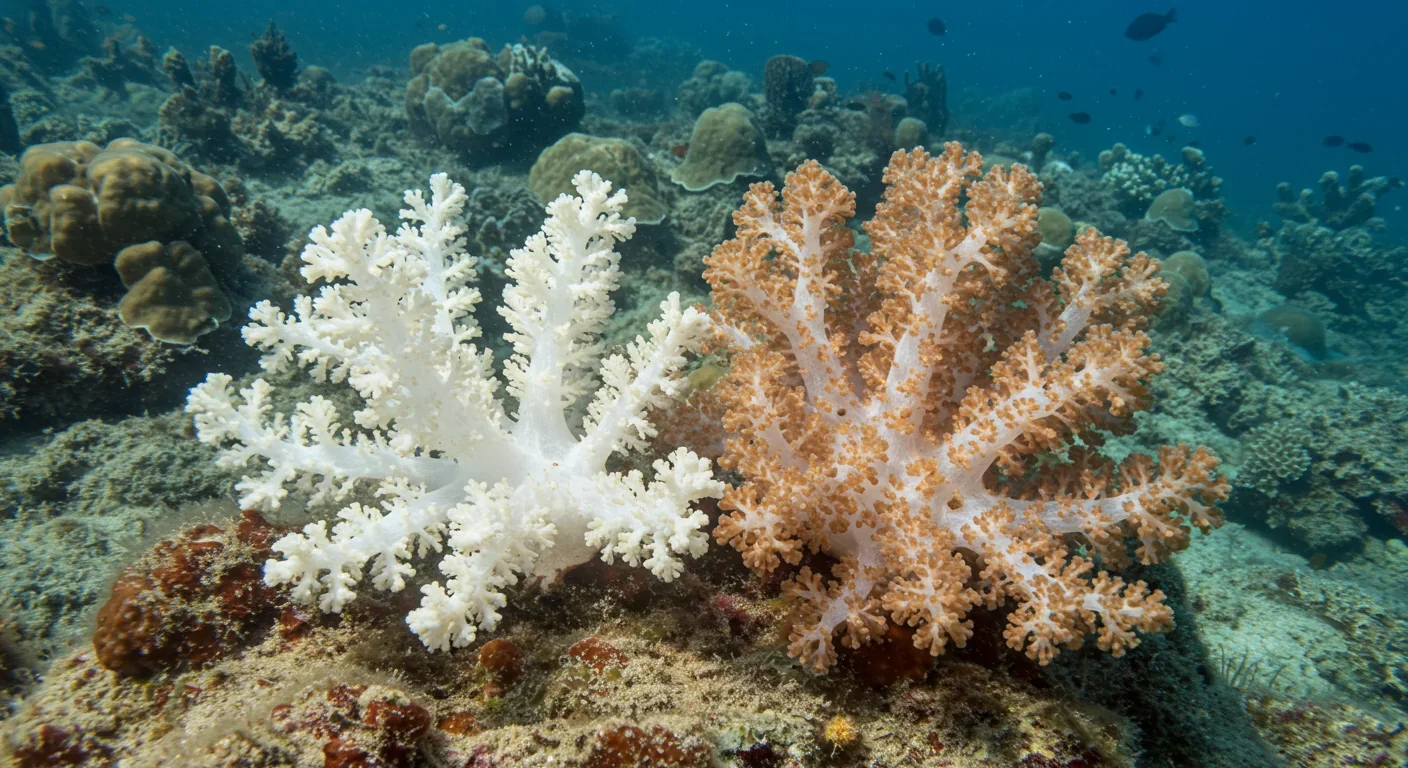
This leaves bleached octocorals defensively naked. Predators like fish and nudibranchs that normally avoid these corals can feed freely on defenseless tissues. Pathogenic bacteria that would typically be repelled by anti-microbial compounds can colonize bleached coral surfaces, leading to disease and death.
The dependence on chemical defense also carries metabolic costs. Producing and maintaining the complex biochemical machinery for toxin synthesis requires significant energy. Studies suggest octocorals may allocate 30% or more of their energy budget to defense-related processes. Under stress conditions when energy is scarce, corals face a cruel trade-off: invest in defense or invest in survival and reproduction.
The pharmaceutical interest in octocoral compounds creates conservation risks. While researchers aim to develop sustainable production methods, demand for natural compounds could drive overharvesting. Some slow-growing sea fan populations require decades to recover from collection damage.
Bleached soft corals lose not just their color but their chemical weapons—leaving them vulnerable to predators and pathogens that would normally be deterred by toxic compounds.
There's also the risk of defensive compound pollution. As octocorals bleach and die, their toxic secondary metabolites release into surrounding waters. In high densities, these compounds could harm other marine organisms, creating localized dead zones.
The future ocean may look radically different from today's reefs. As hard corals struggle with warming waters and acidification, octocorals' flexible architecture and potent chemical defenses position them to dominate.
Research suggests soft corals maintain growth rates and survive better under projected pH conditions than hard corals. Their flexible skeletons made of gorgonin protein, reinforced with small calcium carbonate sclerites, require less energy to build than massive hard coral structures. This gives octocorals a competitive advantage as carbonate ions become scarcer in acidifying oceans.
The transition from hard coral to soft coral dominance is already visible in degraded reefs. After disturbance events that kill hard corals, octocoral communities often expand, creating what researchers call "gorgonian gardens"—dense stands of sea fans and soft corals where hard corals once thrived.
These altered ecosystems function differently. Gorgonian gardens provide three-dimensional structure for fish and invertebrates, but with different spacing and architecture than hard coral. The chemical defenses that protect soft corals also shape the associated community—species that can tolerate or even sequester coral toxins thrive, while sensitive species disappear.
The biodiversity in these shifted ecosystems can remain surprisingly high. West Philippine Sea surveys found octocoral-dominated sites supported diverse fish and invertebrate communities. But the species composition differs from traditional hard coral reefs, with implications for fisheries and ecosystem services.
Human communities dependent on reef resources will need to adapt. Some fish species valuable for food may decline in octocoral-dominated systems while other species increase. Dive tourism may shift as reefs transform from hard coral "gardens" to swaying forests of sea fans.
Understanding octocoral chemical defense prepares us for multiple futures. For pharmaceutical development, the key lies in unraveling the molecular signals corals use to direct symbiont metabolism. Researchers are mapping the genetic pathways octocorals use to control defensive compound production.
If scientists can identify the genes and signaling molecules involved, they could engineer microalgae or bacteria to produce valuable compounds without harvesting wild corals. Several research groups are working toward this goal, inserting coral genes into laboratory algae and optimizing production conditions.
For conservation, the priority is protecting octocoral populations and the reef environments they require. This means aggressive action on climate change to limit warming and acidification. It also means establishing marine protected areas that safeguard both common and rare octocoral species, preserving the genetic diversity that may enable adaptation.
Reef managers are developing strategies for octocoral-dominated futures. This includes identifying sites where soft corals show high resilience, understanding which fish species thrive in gorgonian gardens, and adapting management practices to support these altered ecosystems.
For coastal communities, preparation means diversifying beyond reef-dependent livelihoods and developing restoration approaches suited to soft coral systems. Traditional coral restoration focuses on hard coral fragments, but similar techniques adapted for octocorals could help accelerate recovery in damaged areas.
The broader lesson from octocoral chemical warfare is this: evolution has already solved many problems we're just beginning to tackle. These animals have spent millions of years optimizing biochemical manipulation, cellular engineering, and chemical defense. By studying their solutions, we gain insights applicable to medicine, materials science, and managing ecosystems under stress.
The chemical arsenal of soft corals represents one of nature's most sophisticated partnerships turned weapon systems. As we navigate the challenges of a changing planet, the lessons written in octocoral biochemistry may prove as valuable as the compounds themselves. These delicate-looking organisms, swaying in tropical currents, have mastered the art of turning partners into protectors—a skill humanity might do well to learn.

Lunar mass drivers—electromagnetic catapults that launch cargo from the Moon without fuel—could slash space transportation costs from thousands to under $100 per kilogram. This technology would enable affordable space construction, fuel depots, and deep space missions using lunar materials, potentially operational by the 2040s.

Ancient microorganisms called archaea inhabit your gut and perform unique metabolic functions that bacteria cannot, including methane production that enhances nutrient extraction. These primordial partners may influence longevity and offer new therapeutic targets.
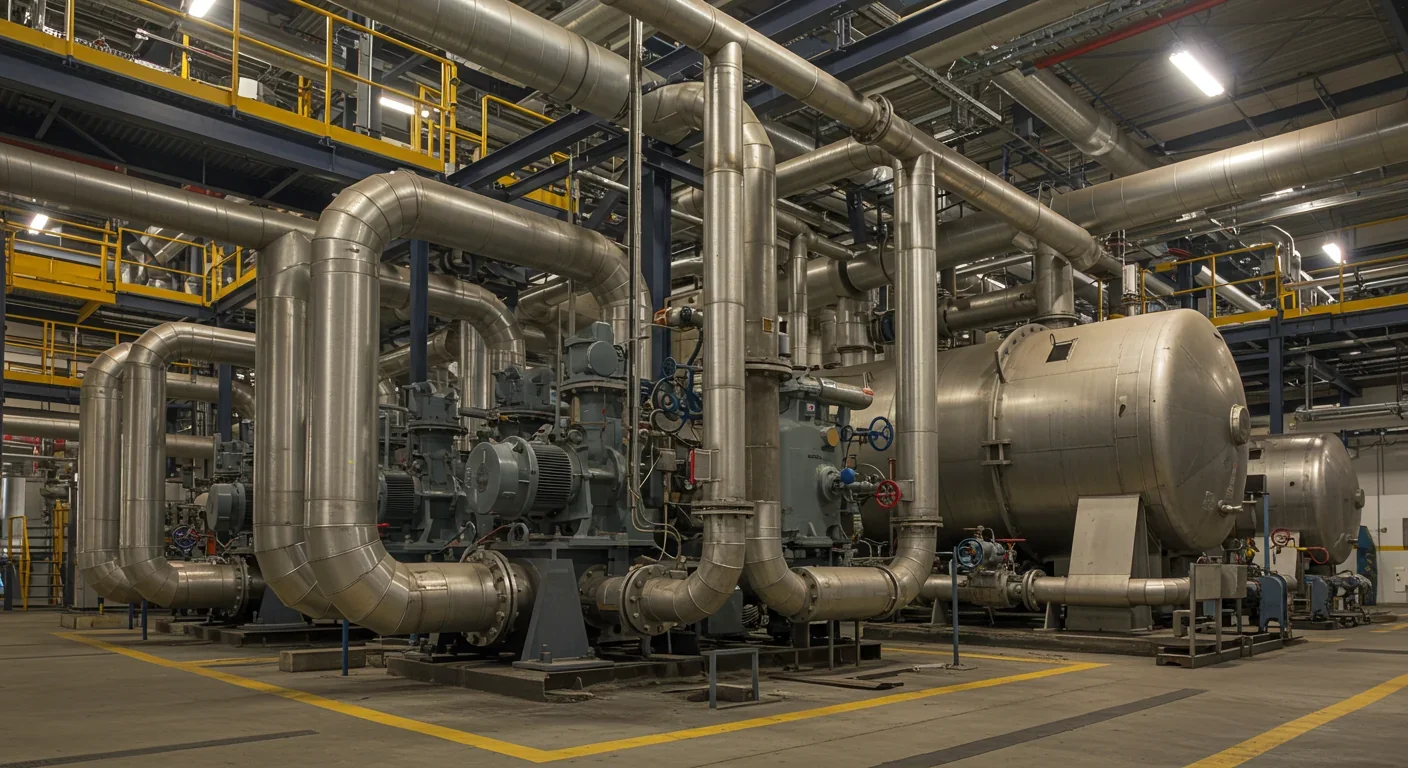
CAES stores excess renewable energy by compressing air in underground caverns, then releases it through turbines during peak demand. New advanced adiabatic systems achieve 70%+ efficiency, making this decades-old technology suddenly competitive for long-duration grid storage.

Human children evolved to be raised by multiple caregivers—grandparents, siblings, and community members—not just two parents. Research shows alloparenting reduces parental burnout, improves child development, and is the biological norm across cultures.

Soft corals have weaponized their symbiotic algae to produce potent chemical defenses, creating compounds with revolutionary pharmaceutical potential while reshaping our understanding of marine ecosystems facing climate change.

Generation Z is the first cohort to come of age amid a polycrisis - interconnected global failures spanning climate, economy, democracy, and health. This cascading reality is fundamentally reshaping how young people think, plan their lives, and organize for change.

Zero-trust security eliminates implicit network trust by requiring continuous verification of every access request. Organizations are rapidly adopting this architecture to address cloud computing, remote work, and sophisticated threats that rendered perimeter defenses obsolete.